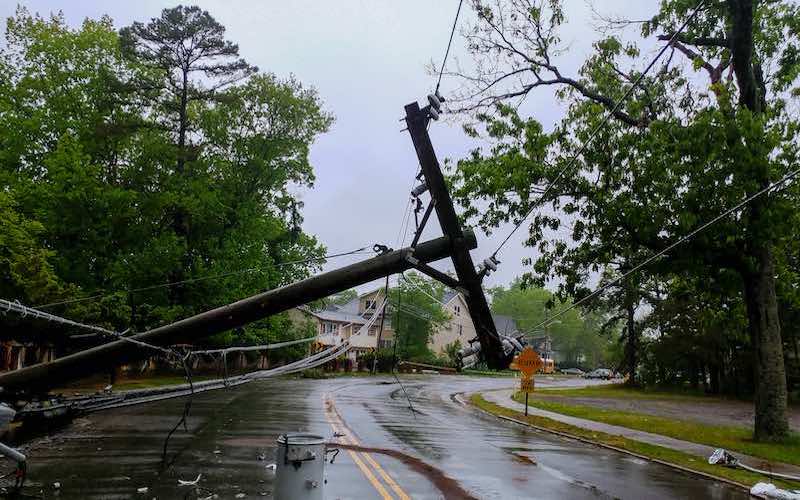
As storms become more powerful and frequent, Rhode Island Energy needs to proactively prepare. Photo: Shutterstock
Your utility company’s job is to keep the lights on and the electricity flowing. Electricity heats and cools our homes, preserves our foods and medicines, and powers our life-saving medical devices. In short, a stable and reliable electrical grid is critical to our health, well-being, and economic prosperity. Yet, stability and reliability of the grid in the face of increasingly powerful storms is the opposite of what we’ve been experiencing across Rhode Island.
Instead, utility customers are seeing more outages after storms. And each time it happens, utility companies re-string power lines and ask customers to foot the bill without making any fundamental changes.
This shouldn’t be happening. Utility companies should be investing right now in preparing electrical infrastructure, like power lines, poles, and substations, to withstand the extreme weather that climate change is bringing us. As storms grow in scope and intensity, as Hurricanes Helene and Milton so devastatingly showed us, they are causing widespread destruction. Utility companies must finally recognize that climate change is here, and our utility infrastructure must be resilient enough to handle it. That’s why CLF is pushing to improve infrastructure resilience in Rhode Island. It’s about time for our utilities to be prepared, not only for the future but for the present.
Repairs Without a Long-Term Plan
In Rhode Island, electricity customers owe Rhode Island Energy $70 million. That sum is meant to cover the costs of past storm damage. But the money customers pay isn’t spent on long-term fixes that reinforce or improve the grid. Instead, the company rebuilds the same vulnerable grid storm after storm, passing the cost on to customers. The result? Our electrical grid is never upgraded quickly enough to withstand stronger winds, heavier snowfalls, and warmer and wetter winters.
Ideally, utility companies would be doing long-term, comprehensive resilience planning. But they aren’t. Despite warnings from other regions – most recently North Carolina, but also Texas in 2021 and New York after Hurricane Sandy in 2012 – the utilities have failed to learn lessons from the now foreseeable and routine disasters unfolding around us. Sea level rise, the growing strength and frequency of winter storms and hurricanes, and predictions of longer and more heatwaves in New England all threaten our electric grid. Yet these threats have not been adequately analyzed, much less prepared for. Because utility companies can pass the cost of repairs on to us, they aren’t incentivized to do anything more.
An Economic Justice Issue
These failures to prepare are not only dangerously shortsighted but also contribute to ongoing race and class inequity. Low-income communities and communities of color are more likely to experience power outages. That means that lower-income people and Black and Brown residents are also more likely to be left to fend for themselves in boiling houses or frigid cold apartments when the power fails. These communities are also often in flood zones. And these residents often endure extended outages that mean food and medicines go bad or access to water is lost. As we saw in Texas, they are often the most vulnerable among us, especially children and older people, both at risk from extended cold snaps and heatwaves.
Research across the U.S. has shown that more affluent neighborhoods currently benefit from more resilient power lines, which leads to disparities in the incidence of blackouts. From our analysis of power outage data in Rhode Island, we found more customer-minute outages in towns with more environmental justice neighborhoods. To add to the disparity, these communities also have less disposable income to pay the higher utility bills that inevitably result when utilities push repair costs onto consumers.
Turning the Focus on Rhode Island
We must protect our communities by ensuring our utility companies deliver electricity safely and reliably. That means ensuring that our present and future infrastructure is built with climate in mind. Families and businesses in Rhode Island should not be saddled with the costs of repairing and rebuilding infrastructure because utilities kept their heads in the sand. Regulators required Rhode Island Energy to go through a grid modernization process in 2022, and the company must file annual storm fund reports, but these don’t get to the root of the problem. Rhode Island Energy must take a comprehensive look at the long-term threats that climate change poses to the grid in the state and go through a public process to propose a plan for how to address vulnerabilities for approval by the state.
Sign up here if you’d like to learn more about how you can help push the state to take the threat climate change poses to our grid seriously.



